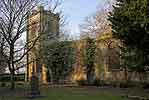For this church:    |
| |||||||||||||||||||||||||||||||||||||||||||||||||||||||||||||||
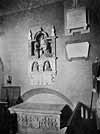 Monument to Sir Monument to SirJohn Byron (d1567) in place in Colwick old church c1915 |
 The monument now The monument nowin Newstead Abbey |
 Incised lid Incised lid |
 Detail of front panel Detail of front panel |
 Detail of left side Detail of left side |
A table-tomb on the north side of the chancel just outside the altar rails to the first Sir John Byron to whom Newstead was granted in 1540, and who died in 1567. On the upper slab are the incised effigies of Sir John Byron and his two wives, much defaced, and an inscription at the feet, which is largely illegible. Round the upper edge is a black-letter inscription that reads:
Here lyeth the bo[dy of Sir John Byr]on Knight Stewarde of manchester And rachdayle livtenante of the forreste of Sherwood et c who departed out of this Transitorye lyffe the third daye of Maye in the yeare of our lord God Mo CCCCCo lxvij. |
His son, John, who was responsible for the design of the above tomb, had his father’s image incised on the lid, and himself on the left-hand side of the front side, with his four sons and his wife and three daughters on the right-hand side, with a shield in the centre comprising the Byron arms, impaling those of Strelley, surmounted by the Byron crest of a mermaid. In this design he makes a statement identifying himself and his offspring with his father. He found it necessary to do this because his father, who had no children by his first wife, had lived openly with the widow of George Haugh before his own wife’s death, and by whom he had several children. He did eventually marry his mistress but had found it necessary to legitimise his son John’s position and succession to the estate by deed of gift. According to Thoroton “having loved his wife something to soon and sought the priests blessing on their union something too late for decorum”.
On the west end are three shields on which the Byron arms appear. Around one of the shields is 'Isabell Byron daughter of Mr Lemington' in recognition of Sir John’s first wife. On the east end are two shields on one of which the Byron arms impales the arms of Consterdine in recognition of the second wife.
2Sir John Byron (died 1604) and his wife, Alicia
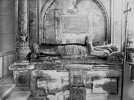 Monument to Sir John Monument to Sir John Byron (d1604) in place in Colwick old church c1907 |
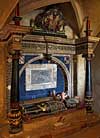 The recoloured The recolouredmonument now in Newstead Abbey |
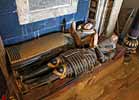 The effigies of The effigies of Sir John Byron and his wife, Alicia |
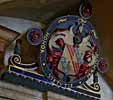 The arms of Byron The arms of Byron |
On the south side of the chancel was the massive alabaster tomb of his son, Sir John Byron, Knight of the Bath, bearing the effigies of the Knight and his wife, Alicia, daughter of Sir Nicholas Strelley, Knight, of Strelley. Sir John, who died on 24 February 1604, is represented in plate armour with a skirt of lances of metal, goffered frills round his neck and wrists, a long chain round his shoulders, sabbatons and a short-hilted sword. He is shown as wearing a moustache and extravagantly long beard. His wife lies at his right side. The effigies have evidently at one time been coloured. Round the chamfered edge is a prettily-lettered inscription, recording their names and those of their children, whilst on the wall, within an arch beneath the entablature, which is supported by carved pillars, is a long and nearly illegible inscription in Latin. In the spandrels of this arch are two shields of arms, viz., Byron, quarterly of four 1st and 4th argent, three bendlets enhanced gules (Byron); 2, argent, on a bend azure three annulets or, in the sinister chief a cross crosslet fitchee sable (Clayton); 3, gules, three fusils conjoined in fesse argent, in chief two cinquefoils pierced or (Colwick), and Strelley, quarterly of four, 1 and 4, Paly of six argent and azure (Strelley); 2 or, an eagle displayed sable, beaked and membered gules (........); 3, a fesse dancettee sable (Vavasour). On the front of the entablature are the quartered arms of Byron, surmounted by the crest of that family, viz., a mermaid proper, crined, and holding in her dexter hand a mirror, and in her sinister hand a comb, or, surrounded by a motto: "Honor virtutis premium." On the panels of the structure are some laudatory verses, nearly illegible, [see transcription published by Fellows in 1916 below] and three shields of arms, viz., Byron impaling Lozengy argent and gules (Fitzwilliams); 2, argent, three bulls' heads erased sable, armed or (Skeffington), impaling Byron; 3, gules, three sparrow hawks argent (Atherton), impaling Byron.
|
This monument has been restored to its former colours since installation at Newstead Abbey.
3Sir John Byron and his wife, Margaret (both died 1623)
 Monument to Sir John Monument to Sir John Byron (d1623) in place in Colwick old church c1915 |
 Recoloured monument Recoloured monumentat Newstead Abbey |
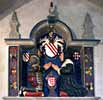 Detail Detail |
 Detail Detail |
There was also a wall monument hung above tomb 1 in which two sets of male and female figures are shown kneeling. This monument is to Sir John Byron and his wife Margaret (both of whom died in 1623) and also to their eldest son John who died in 1625 and their eldest daughter, Alice.
An inscription tablet reads:
|
These were the last of the Byrons to be buried here before their move to Newstead Abbey.
The Musters Monuments
In May 1937 the Parochial Church Council gave permission for Colonel Chaworth Musters to remove the monuments from the church erected to members of his family and the window glass in the east end painted by Sophia Musters. They were taken to All Saints Church, Annesley.
1On the south wall of the chancel, there was a large marble wall panel, above which was a bust of Sir John Musters and draped with a skull, 1689. This is the Sir John who restored the church in 1684.
See the Annesley All Saints entry for further information and photographs.
2On the north side of the chancel was a classical marble chest tomb with corniced back panel, carrying two life-size figures in Roman dress, to John Musters and Millicent, his wife. On the monument is a shield of arms showing Musters impaling those of Mundy. John Musters predeceased his father, dying at the age of 37 in 1685 (See 1) The memorial was erected by his widow in 1689. She died in 1739 aged 86.
See the Annesley All Saints entry for further information and photographs.
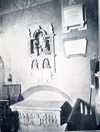 North chancel North chancelmonuments in c1915 |
Mounted on the north wall of the chancel were two white marble tablets bearing the following inscriptions:
IN MEMORY OF |
SACRED |
It is not known where these tablets are now.
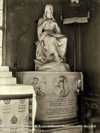 Monument
to Monument
toSophia Musters in place c1900 with thanks to Picture the Past |
On the south side of the altar, above, seated draped female figure sculpted in white marble representing 'Resignation' and signed 'R. Westmacott R.A., London.' To Sophia Musters, 1819. Richard Westmacott is an important artist whose work may be seen on the pediment of the British Museum and who sculpted the statue of Achilles in Hyde Park in London. He was a pupil of Antonio Canova, who sculpted The Three Graces.
Besides being a talented painter herself, she was noted for her beauty, and was painted by great artists such as Hoppner, Reynolds and Romney. She was also lady of the bedchamber to Queen Charlotte.
The three panels on the pedestal depict Sophia’s three talents: painting, music and dancing.
See the Annesley All Saints entry for further information and photographs.
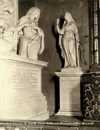 Monument to Monument toMary Musters (and part of the Monument to John and Millicent Musters) in place c1900 with thanks to Picture the Past |
North side of chancel next to the altar there was a classical square marble pedestal with three-quarter size standing female figure to Mary Ann Musters, 1832.
Mary Ann Musters (née Chaworth) was a distant cousin of the poet Byron, who fell desperately in love with her in 1803 when he was sixteen and she eighteen. Byron told a friend, he found in Mary all his youthful fancy could paint of the beautiful. But Mary didn't care for the 'lame, bashful, boy lord' and married John 'Jack' Musters in August, 1805.
When Mary’s marriage deteriorated, she started writing to Byron. Mary separated from her husband and in 1814 tried to visit Byron in Hastings without success. In the following years she became mentally unstable. She died in 1832 at the age of 47. Her weakness and eventually death, it is said, was the result of exposure to the cold when hiding in the woods and sleeping in the stable when rioters advanced on Colwick Hall in October 1831 after parliament’s rejection of the Reform Bill.
See the Annesley All Saints entry for further information and photographs.
6
 The interior of the church The interior of the churchlooking east c1920 showing the monument to the left of the chancel arch |
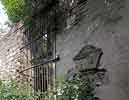 Remains of the mural Remains of the mural monument in 2018 |
Old photographs show that there was a marble tablet on the north wall of the nave.
The remains of this monument are still visible in the ruined church but the inscription has not survived. It may be the memorial to a former rector recorded by Godfrey (1893):
| Sacred To the memory of The Revd William Thompson, upwards of thirty two Years Rector of this Parish, and of the Parish of West Bridgford. He was also an active, intelligent, and upright Magistrate for this County. He died May 4th 1803, Aged 61 Years. Also to the Memory of Sarah, Relict of the above Revd. William Thompson, who departed this Life the 9th of September 1820, Aged 88 years |
Hatchments
In addition to the monuments, there were also four Hatchments of Arms. The first, for a widower, bore the arms and crest of Musters. The second was similar for a wife. The third was quarterly: (i) Musters; (2) Mundy of Markeaton; (3) Or, within a bordure sable, three goats saliant; (4) Sable, a griffin or, between 3 crosses pattee fitchee.
Clarkeston family floorstones
There were two floorstones to members of the Clarkeston family who died in 1645 and 1648 and were buried in the nave of the church at the tower end. John Clarkeston, who died in 1645 was the originator of Colwick cheese.
Testamentary burials recorded in Torre Manuscripts:
| 1433 | Richard Aderley to be buried in churchyard or church about his parents. | |
 |
||
| 1436 | Elizabeth Aderley – late wife of Richard to be buried in churchyard against her late husband | |
 |
||
| 1496 | John Holme, late Rector of Colwick | |
 |
||
| 1504 | Nic Byron, Kt | |
 |
||
| 1567 | Sir John Byron of Newstead to be buried in the church where he willed a priest 'to sing mass for his soul and his ancestors ten years after his death and to have for his stipend £10 per annum'. This provides evidence that this tomb was used as a Chantry altar, long after chantries had been suppressed particularly as two consecration crosses are visible at the corners. | |
 |
||
| 1623 | Sir John Byron of Lynby to be buried in the chancel near his father’s monument | |


